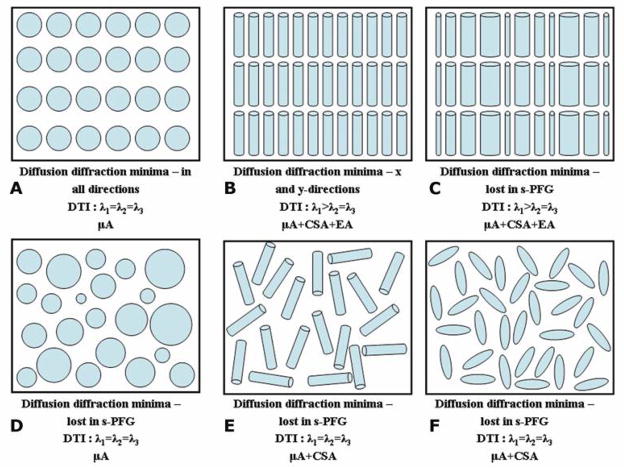Figure 3.
Restricted diffusion in various compartmental scenarios, the microstructural parameters that are available from s-PFG and the types of anisotropies present. (A) A schematic representation an ensemble of monodisperse spherical compartments. Generally, it may be very difficult to infer on restricted diffusion in such cases using DTI. At higher q-values, the diffusion-diffraction minima will appear in all directions, conveying that this system is indeed characterized by restricted diffusion. The diffusion-diffraction minima also enable inference on the spherical nature of the compartments. In this case, microscopic anisotropy (μA) exists, arising from the boundaries of the compartments. (B) A schematic representation of monodisperse cylindrical compartments coherently aligned in a certain direction. Note that since the compartments are cylindrical and non permeable, compartment shape anisotropy (CSA) also exists, as does μA; since the cylinders are coherently packed, EA exists in this scenario as well. DTI parameters will be able to convey the ensemble anisotropy of the sample. The diffusion-diffraction minima will appear in the restricted direction, from which the size of the monodisperse microcapillaries will be extractable. (C) A schematic representation of coherently packed cylindrical compartments characterized by a size distribution. The same types of anisotropy are present as in (B); DTI parameters will be able to extract the ensemble anisotropy of the sample. The diffusion-diffraction minima, however, are lost, along with the important microstructural information they produce. (D) A schematic representation of spherical compartments characterized by a size distribution. In this case, the diffusion-diffraction minima are lost, and the presence of restricted diffusion will be hard to infer. As in (A), only μA exists for this sample, as it is spherical. (E) A schematic representation of randomly oriented compartments of cylindrical shape. (F) A schematic representation of randomly oriented ellipsoids. In both (E) and (F), the s-PFG methodologies will not be able to extract meaningful microstructural information. In both (E) and (F), both μA and CSA exist, but s-PFG methods cannot distinguish between the two. The compartment shape anisotropy in (E) is different from (F) since the compartments are cylindrical and ellipsoid respectively.

